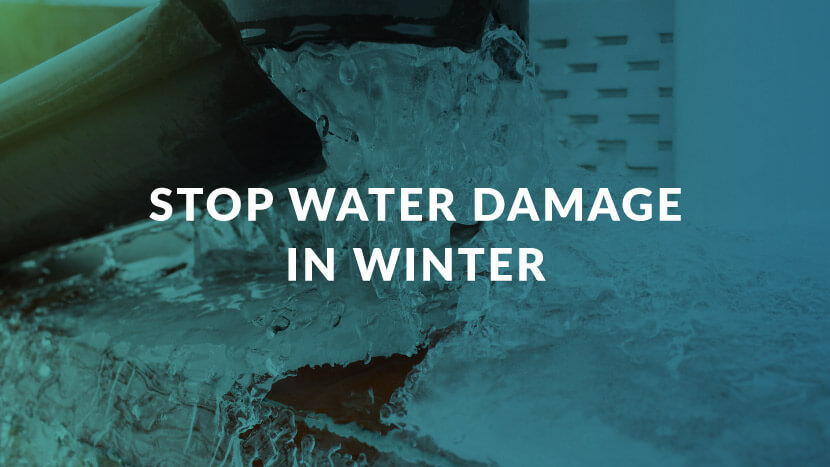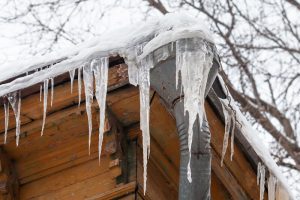
How to Prevent Water Damage in Winter
Water damage can happen despite seasonal weather changes. But winter means cold or freezing temperatures, which brings an increased risk of plumbing issues that can affect your home or business. Read below to learn more about how to prevent water damage in winter.
If you need help with water damage that’s occurred inside your home or business, no matter what time of year it is, keep CLEAR Restoration’s water damage services in mind. Our specialists have years of experience in water damage restoration in the winter and can help you return to your everyday life.
Common Causes of Water Damage in Winter
Freezing temperatures and water blockages will often increase water pressure, which causes one of the biggest winter water damage issues: potential for pipes to burst and release water into the home.
Another cause of winter water damage is clogged gutters. When water from melting snow or ice is not able to drain through your gutters because they’re clogged, it can seep through and get into your attic. When water seeps into your attic, it can then leak into other areas of your home, causing massive water damage by ruining structural beams, drywall, ceilings, and more.
If winter water damage does occur because of leaks, you should call CLEAR Restoration’s emergency number at 225-245-3575. Our water restoration experts will come to your home and fix the urgent situation 24 hours a day, seven days a week.
[Related: Ceiling Water Damage: What to Know]
Burst or Frozen Pipes
Winter can wreak havoc on the interior and exterior pipes leading in and out of your home.
One common cause of water damage in winter are pipes that burst or become frozen in cold weather. If you do find that a pipe’s frozen, be careful when trying to thaw it out because there is a risk of the pipe bursting from built-up pressure.
One solution to preventing burst or frozen pipes is by letting cold water drip from the faucets that are served by exposed pipes outside the home. This will keep the water flowing within the home and prevent it from freezing.
Another great solution to prevent this issue is by lowering the home’s temperature so the interior is more consistent with the colder weather outside. If you will be away from the house for more than one day during winter, then you should set the thermostat to a lower temperature, but make sure you keep it above 55 degrees Fahrenheit. It will keep the pipes at a more consistent temperature so there are no major swings of adjustment. If the temperature drops suddenly in your home and thus makes the pipe’s temperature drop as well, the pipes will be more likely to crack and let water seep through. Pipes should be gradually warmed or cooled to prevent cracks.
As a bonus, lowering your home’s temperature will let you save money since you’re not using as much energy to heat your home.
 Roof Leaks and Ice Dams
Roof Leaks and Ice Dams
One of the most common areas to find water damage in the winter is on your roof. The roof is often one of the most vulnerable areas of the home if steps aren’t taken to keep it protected. Once trapped ice that is unable to flow off the roof melts, then that water will find a way into your home by seeping under old shingles, into cracked sealant, or through other weak spots. Once the water gets into your attic or home, it can cause mold growth or structural damage. If that does happen, our mold remediation specialists can look at the extent the mold has affected the roof.
Another area that is often a trouble spot is the gutters. If the gutters are clogged, any snow that melts off your roof won’t pass through the drainage system properly. This leads to water building up along the structure. From there, the trapped water will refreeze and develop ice dams. An ice dam is when ice develops along the edge of the roof and stops snow from draining and falling off. When an ice dam occurs, water can find ways into your home and cause more damage.
[Related: Dangers of a Leaky Roof]
Water Damage in Winter Prevention
So how do you prevent water damage in winter and avoid potential risks to your home?
One of the best ways to avoid any winter water damage from occurring is to make sure your home’s pipes are insulated in unheated areas. You can also install pipe sleeves for this purpose. Either of these tips will help your pipes stay warm and stop any ice from forming and blocking the flow.
Another way to prevent winter water damage is by cleaning the gutters on your home’s exterior before any cold weather hits. On the rare occasion that snow hits your area, be sure to double-check that your gutters are draining properly. This will help make sure water doesn’t build up in one spot, such as under your home’s shingles, and cause a blockage.
These prevention tips are easy to complete and are an easy way to stop any winter water damage from occurring. Yet if you need help after winter water damage occurs, don’t hesitate to reach out to CLEAR Restoration.
Prevent Water Damage in Winter by Calling CLEAR Restoration
Dealing with water damage is challenging 365 days a year. But having water damage in the winter can lend itself to all kinds of problems for your home if they’re not fixed as soon as it happens.
If you need help with any winter water damage, our IIRC-certified water damage cleanup specialists at CLEAR Restoration can help restore your property back to its original condition. Learn more about our water damage restoration services and contact us today by calling 225-245-3575 if you’re concerned about any winter water damage in your home.




